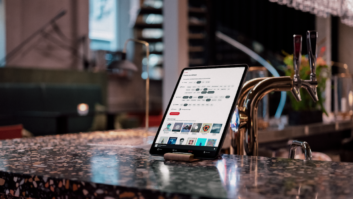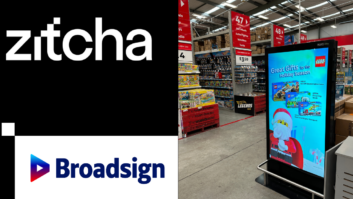According to leading commercial property and real-estate services adviser CB Richard Ellis, retail investment activity in Europe slowed to €18.1 billion in the first half of 2008 (the last period for which figures are available). While this number is comparable with the same period in 2005, it is well below the previous two years’ six-monthly average of €28.5 billion. And this before the so-called ‘credit crunch’ really started to make itself felt… But is this downward trend in overall investment likely to affect the market for audiovisual solutions for retail in 2009? The industry is, in fact, surprisingly bullish.
“I expect the market to be good in 2009 as there will be more competition between retailers as they seek new ways to promote and differentiate themselves on the high street,” says Lloyd Cole, European marketing manager at 3M’s Optical Systems division. “They are all looking for solutions that will help them out of the downturn and the digital signage opportunity presents a great advantage for forward thinkers.”
Many commentators on the economic situation say that it’s those companies that spend more than their competitors on marketing that will succeed. It is also those that adapt best not only to the macro-economic situation, but the micro-economic situation too, that will perform more strongly.
“It’s well documented that digital signage is a great way of promoting products, as well as advertising in-store,” says Peter Critchley, managing director of Beaver Group, a company that specialises in the development, production and deployment of digital signage solutions. “But it’s also valuable as a way to react quickly to situations. Instead of just running normal messages to promote products, screens can be used to give direct and relevant information to buyers. With situations changing so quickly, this kind of up-to-date information can help a retailer achieve real competitive advantage.”
Simon Taylor, general manager of the UK and Northern Europe office at LED display manufacturer Lighthouse Technologies, agrees. “If any market sector is going to see some sort of stability, it’s likely to be retail,” he says, “because there is an increased requirement to draw people in to outlets – something for which LED-based solutions have proven to be particularly effective.”
Implicit in these remarks is the knowledge – based on extensive industry experience – that audiovisual applications such as digital signage have been proven to deliver quantifiable benefits to retailers that positively impact their bottom line. However, some change is apparent. If any retailers ever installed digital signage solutions purely for their wow factor or their perceived prestige, they’re unlikely to continue to do so.
Critchley again: “As the cost of technology goes down, I think that more simple applications will become prevalent. More retailers will use AV in their store, but not as a ‘boundary pushing’ installation. AV will become a standard, rather than being a luxury or a high-spec gimmick.”
“Although we have seen a few projects pushed out, we are also seeing new projects come in all the time,” notes Pierre Gillet, vice president of European sales at digital media company Roku. “The market is very cost- and return on investment-sensitive at this time – which means it’s a good market for suppliers of technology that is low-cost, easy to install and maintain, and reliable.”
Seeking returns
That’s a point of view that finds broad favour in the industry. “Many more retailers will be looking for more substantial returns on investment in 2009, and this will set a trend for the future,” says Ian McKenzie, chief executive officer at digital signage specialist Dynamax Technologies. He also notes that attendance figures at January’s National Retail Federation convention in New York were ‘significantly’ down on previous years. He believes this indicates a higher degree of caution on the part of retail companies. “As a result, retailers are looking for a more unique approach to interactive technologies, such as two-way communications, to keep consumers engaged.
“In 2009, we’ll see increasing use of geotargeting, in-store kiosks, and shelf-edge and mobile communications used on an integrated basis to communicate with consumers. In addition, we will continue to see more facial recognition technology applications being used to more effectively tailor certain marketing messages to specific types of consumers in retail.”
Cole agrees. “I think retailers will become braver and a lot more innovative in terms of experimenting with new technologies such as Bluetooth, SMS, interactivity and beyond,” he says. “In line with their incredible focus on customer insight, they will be more open to trialing such new technologies to maintain and expand customer loyalty.”
In other words: while it seems that the roll-out of mainstream digital signage projects is likely to continue, with the lower costs noted by Critchley bringing new customers into the market, McKenzie and Cole believe that perhaps the real opportunity lies in innovations that extend their reach and persuasiveness.
One of those may well be the Virtual Salesperson, on this occasion created by Dutch agency Boost Products using Vikuiti Rear Projection Screen technology from 3M. A video of a shop assistant promoting a specific brand was produced by Boost and the screen was laser cut to the human shape by the distributor. The screen was then placed on the shop floor next to a sales display and the projector was installed on the ceiling. The projector connects up to the Boost narrowcasting system, which controls play out of the video from a remote location. Once the video is playing, the Virtual Salesperson ‘comes alive’.
That the Virtual Salesperson was designed for a supermarket is almost certainly significant, in that commentators believe that stores selling food and other necessities are likely to be least impacted by the economic downturn. And, as any industry professional will confirm, there is no single retail market. Rather, it is a complex amalgam of smaller markets, each with its own unique characteristics. Success in 2009 and beyond is likely to be determined by how well the AV industry understands that segmentation and identifies the likely winners and losers – and precisely what it is that those winners will want.
Meeting in the middle
Size, as in so many things, is probably important. “Our best opportunities at the moment are small to medium-level installations in mid-size retailers – let’s say five to 20 screens in chains with 20-500 outlets,” says Gillet. “It is easier to measure and justify the return on a smaller-scale roll-out – and the decision-making chain is shorter in mid-size businesses.”
And that’s a key requirement for many AV companies during challenging times. Which projects will generate a near-term return not only for their customers, but also for themselves? “There is always a huge amount of difference between the sectors, and we are very specific in the ones we actively target,” says Barrie Guy, large format LCD & solutions sales manager at NEC Display Solutions. “The smaller chains tend to be very good to work with because the decision-making tree is so much smaller – that makes life much easier. You can tell from a properly planned exploratory meeting whether they have funding, whether they’re being realistic in their aims and whether they have the commitment to go through all that is needed to launch a project and see it through to completion.”
“We have to be more targeted in both our marketing and our sales,” says Taylor, “and more focused on immediate business.”
A pressing need for many retailers may be to ensure that their security systems are in order. “Regrettably, when recession strikes, there is usually an increase in retail theft,” says Dean Kemp, sales manager, security division at Mitsubishi, “so we would expect to see an increase in demand for security products such as DVRs and CCTV systems if the current economic difficulties continue. Beyond this, security will continue to be a foremost consideration in the minds of those in charge of major public spaces such as shopping malls. The threats of crime and terrorism are still present, and I feel sure that all major retail and public space projects will continue to make every effort to ensure their security systems, public display systems and so on are kept effective and up to date.”
Recurring theme
Unsurprisingly, the questions of cost and return on investment are recurring ones. “In the current economic climate, retailers are focusing attention on saving money while also maximising the number of people in store,” notes Critchley. “While digital signage is able to do this over time, the initial investment can be enough to put off a retailer. Software-as-a-Service providers like Beaver Group may well see an increase in interest, as clients take a cautious approach to digital signage.
“Beyond that, trying to sell advertising space or a business model based on a 10-year return on investment is probably not going to be a compelling case. In the end, it’s about identifying which retailers really can benefit from an AV solution and how. In this climate, some retailers will not benefit. As suppliers, success will come from being realistic in our approach and understanding the limits of the market.”
“Clearly, we planned the release of our 2009 Compact range well before the start of the credit crunch – but we couldn’t have timed the launch better,” smiles Gillet. “We are offering a high-quality looping player at a remarkable new price point – and it’s very inexpensive to add networking and interactive support. I don’t see any other vendor offering such a complete and cost-effective range of ‘credit crunch-ready’ digital signage platforms.”
Now more than ever,” he continues, “customers are looking for value and a fast return on investment. As we go forward, we’ll be building on the ‘just pay for what you need’ design philosophy of our new products.”
McKenzie, too, notes the importance of providing an exact fit with a customer’s requirements. “A key element of our point of view digital signage software application is its capability to be flexible,” he says, “and in particular, its capability to be scalable and deliver exact targeting.”
Back to basics
Identifying appropriate markets, providing attractive entry price points, delivering exactly what the customer needs – and no more – are the keys to success for manufacturers and integrators alike. But these aren’t new insights: the economic situation hasn’t changed the basics of good marketing, sales and customer service. Rather, it has served to refocus attention.
“Offering full-service solutions that provide minimal risks, based on reliable products that have minimal downtime and are backed by good service – those things haven’t changed,” says Taylor. “The same with ease of installation, ease of operation and low lifetime cost of ownership. They’re just even more important now than they were before.”
Fraser McDonald, UK sales manager for visual information systems at Mitsubishi, agrees. “We believe delivering the latest technology is important, with a particular emphasis on energy-saving features, longevity and low cost of ownership,” he says. “For example, with our new Seventy Series cubes, we’ve redesigned the colour wheel and fan pack components to greatly extend their working life to something over 100,000 hours mean time between failures. We believe this kind of attention to detail is important, especially when retailers are looking closely at every euro spent.”
“While a digital signage network can have an almost immediate impact on sales lift in stores, with outstanding content, excellent branding, and compelling messaging, it’s really the strength of the retail brand and the in-store experience that keep the consumer coming back again and again,” says McKenzie. “If the consumer experience of visiting the retail outlet is a pleasurable one, then it’s quite likely they will return.”
“Today’s consumers prefer to be communicated with rather than marketed to,” he goes on, “so those retailers who engage and communicate, no matter what area of retail they are in, are more likely to be the survivors of tomorrow.”
It’s hard to talk to the industry without developing the impression that, despite the widespread gloom that is enveloping the retail world, the majority of those companies who serve it with a range of audiovisual solutions are quietly convinced that bad times for retailers may mean good times for them. “We are very positive about the business outlook in retail and signage in particular as we have a number of very exciting solutions coming through,” says Guy.
And, it seems, he should be. Jon Levenson is managing director of Peel Advertising. His company is an extensive user of audiovisual technology in retail environments – including installations such as the UK’s Trafford Centre shopping mall.
“At a time of economic downturn, AV systems and new AV technologies – such as 3D, and the interactivity that fires the Wii generation – are more important than ever,” he says. “The effect on the market should be increased investment in new and better systems, and more innovative ways of communicating your message to an increasingly discerning audience.
“I think, from a shopping mall perspective, the visitor experience has become more theatrical and experiential. We provide more than just a shopping venue – we provide an entire day out. This switch in shoppers’ retail habits will spread across the various sectors, including chain stores and supermarkets. Offering great customer service and value will help ameliorate the effects of the recession. All sectors can weather the downturn, but only those imaginative enough to invest in themselves will see the other side intact.”
Spending on safety and security systems is unlikely to suffer – and may, in fact, increase – although, in the near term, new retail projects may be few and far between. Digital signage, for sure, has a proven track record of driving footfall, increasing customer loyalty and generating additional sales – and while the initial investment might make financial directors shudder, there may be little alternative for retailers looking to improve their competitive positioning: if retailing was competitive before the economic downturn, it is now doubly so.
The primary change, it seems, from the point of view of the AV industry, is that the focus on return on investment is likely to become more intense – but the audiovisual industry is well positioned to respond to that, based on the growing maturity of the digital signage market. The combination of quantitative as well as qualitative evidence and the advent of new, lower-cost systems is likely to make that discussion more straightforward. And the industry is far from short of new technologies, new products and new solutions that will tempt those directors to part with their cash.







